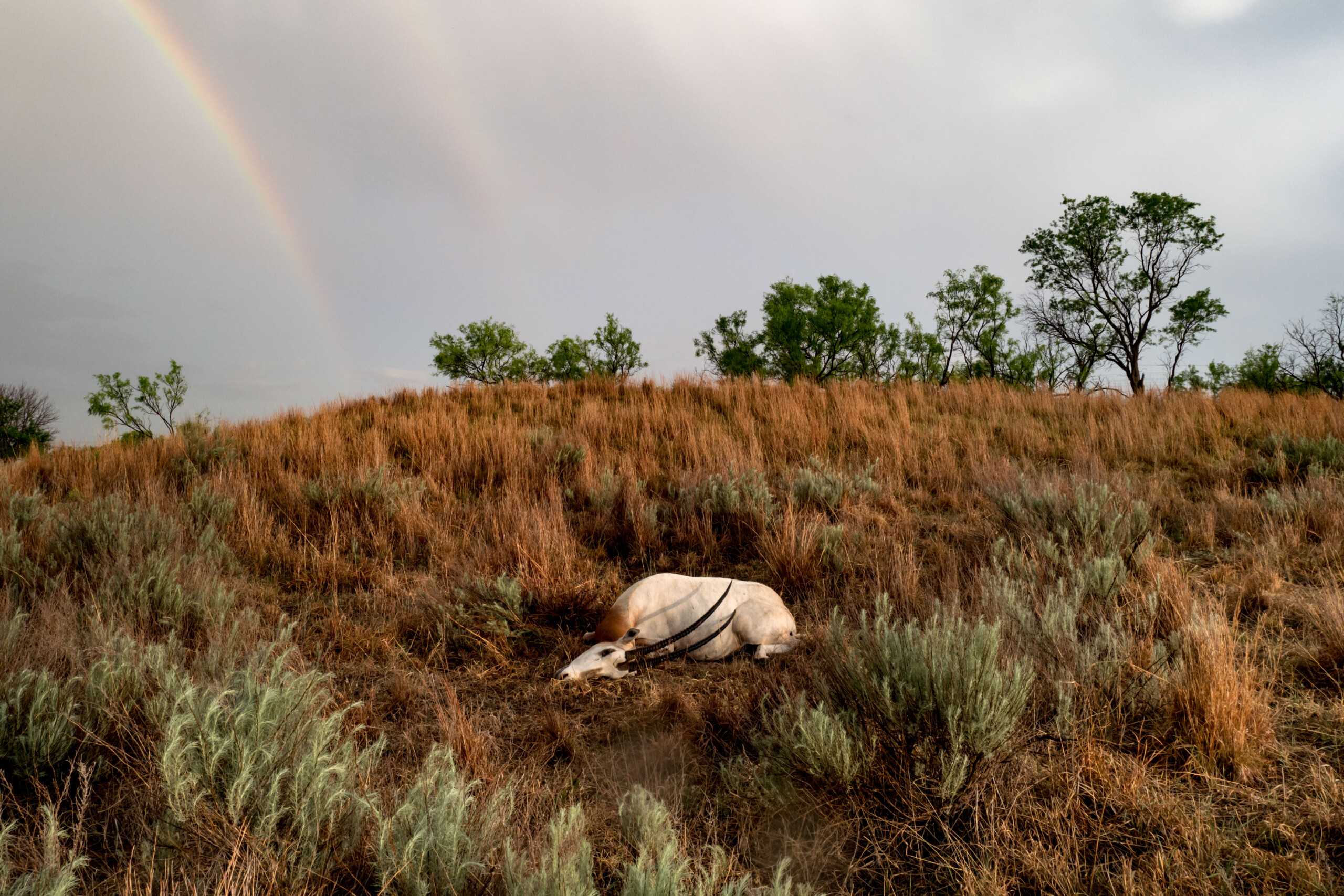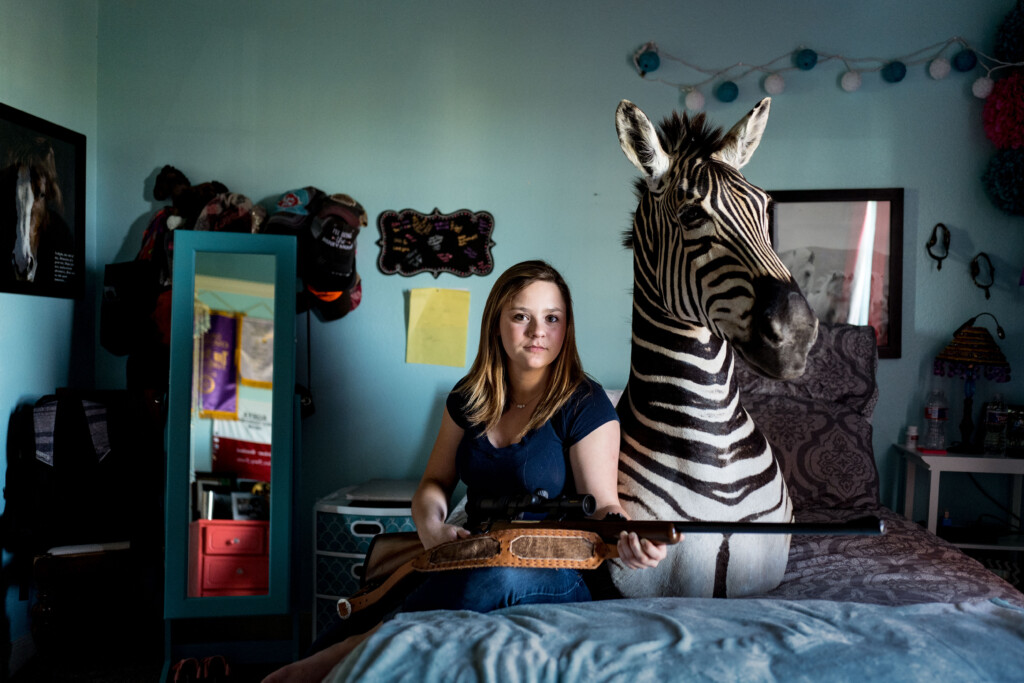









GUP Magazine is media-partnering with Belfast Photo Festival this year. For the occasion, to underline our mutual interest in addressing global issues by way of photography and to make these works available to a wider audience, we have been given the opportunity to select and highlight a few submissions to the Open Call of the Belfast Photo Festival (now closed) from an already incredible longlist. We will feature these selected artists throughout the month of June.
In one of the many striking images of documentary photographer Mélanie Wenger‘s project ‘Sugar Moon’, we see hunting outfitter and taxidermist Erik Grimland unloading the large, taxidermied bust of a zebra from his trailer in Amarillo, Texas — a trophy from his daughter Sydney’s successful hunt in South Africa two years prior.
For ‘Sugar Moon’, Wenger closely followed Erik Grimland and his family in their endeavors over the course of three years. They own and operate Rockin G Ranch: one of countless hunting outfitters in Texas that make up the epicenter of the lucrative exotic game and hunting industry of the United States. With that, or along the way, besides a documentation of her experiences living amongst the unique, unshakable hunting culture of America’s Deep South, Wenger’s photographs also paint a conflicted, intricate portrait of Trump’s America.
‘Sugar Moon’ continues the French photographer’s long-standing investigation into conservation issues across the globe, exploring a multi-billion dollar industry whose existence has long been split by a fierce ideological debate between steadfast hunting advocates like Grimland, and those they call ‘anti’s’. In an interview with GUP, she spoke of the genesis of her long and deeply invested project.
What prompted your personal interest in the world of the exotic game industry? Have you had any experience in hunting yourself, or are you approaching the subject in an entirely detached manner?
I have been working on conservation issues for a decade. After following wildlife trafficking, anti-poaching teams and American hunters in Zimbabwe for a French magazine, I heard about US ranches proposing exotic game hunts on Texan land. It sounded so absurd to me that I kept digging to find out more. I am not a hunter myself and I don’t have a background or education in the world of hunting culture but I am a documentary photographer. In my work, I focus on the interactions between humans and animals. I like to immerse myself in a world that I do not understand at first, and to question the actions of very unique personalities. I don’t intend to take sides but rather to understand and show the complexities of human beings. Erik Grimland, the main character of Sugar Moon, is one of those characters. With his story, I wanted to depict this particular community in the Deep South of the US and its hunting culture.

Exotic ranchers are understandably wary of the media, and I assume prefer to keep their business relatively private — could you give us a bit of insight into the experience of approaching these exotic ranchers in order to photograph their operations? Were there any experiences that stood out to you?
I tried to activate my contacts but as usual faced resistance. Eventually, I emailed a large number of the 500 Texas ranches that are known to own exotic animals. The research took me months. Eventually, Erik answered: ‘Yes, Ma’am, let’s talk’. Erik is perfectly aware that people hate him for what he does, but he openly does not care. He invited me to the ranch; I bought a plane ticket.
I landed in Texas on January 3rd 2018 with a suitcase and no return ticket. We had agreed to meet at the Dallas Safari Club Convention, the biggest hunting convention in the country. He was pulling a trailer full of mouflons that he had bought for a future hunt. We drove 6 hours north, on a straight, flat freeway, before reaching Turkey, Texas. I documented the Rocking G Ranch with Erik’s family for about three years, along with the industry in general: the big ranches of the south, the outfitters and the young hunters. My experience following hunters and anti-poaching teams in Africa made my presence considerably easier. I never promised biased coverage of any kind, but I guess time helped me to blend in. Eventually I got the access I never thought I could have. Of course, I had to face a few wild animals to stay around.

You have previously described the story of the exotic game industry as a “schizophrenic” one. What do you mean by this? Does it perhaps have something to do with the inconsistencies in the arguments made for the industry, and the conflict between fact and fiction when making those kinds of arguments?
This work is not a plea for hunting. It is not an advocate for hunting, nor is it a critic of it. It humbly tries to understand the complexities of the practice. And to reveal the nuances: the truths as well as the contradictions.
Its supporters are formal: legally killing an animal is a way to save many of them, in addition to helping to conserve large areas of wilderness that are increasingly threatened by galloping demography and unbridled urbanization. It’s an argument that provokes an outcry from animal rights groups and some environmentalists.
“But beyond the economic and conservation aspect of this duality, Sugar Moon also questions the confusion that exists between love and possession.”
This debate raises several questions: can we kill an animal to save 1,000 others? Does hunting have a part to play in the effort to conserve wildlife and the environment? Should it be part of it? And if so, how? The economy of trophy hunting in Africa and the United States is colossal, an industry based, also, on entertainment. But where does the money really go? And how is it used by institutions? Does it systematically benefit local communities, as hunters claim? So many questions have surrounded this activity for several decades, yet it has been practiced by Man since he first began to walk the surface of this planet more than 200,000 years ago.

The schizophrenia lies there. Putting a value on an animal, and hunting it, might even eventually save its species. There are some arguments opposing this theory, and some are really valid. But one has to recognize that there are greater numbers of some populations of animals bred in semi-captivity in Texas than can be found in their natural environment.
There is also an important economic side to the story. Hunting exotic game is a billion dollar industry; it creates money and jobs everywhere in the world. Specifically in African countries. And sadly, way more than photo safaris do.
But beyond the economic and conservation aspect of this duality, Sugar Moon also questions the confusion that exists between love and possession. There is this unique conception in trophy hunting where the hunt might be as important as the trophy. The animal you choose to hunt is immediately transformed into an object. The hunter imagines a fancy rug made from the animal’s skin, an elaborate table decoration made from the antlers or a great addition to a trophy room before even pulling the trigger. Yet the omnipresence of animals in their homes also translates as a deep love for them, and that is why I characterize this story as schizophrenic.
“The schizophrenia lies there. Putting a value on an animal, and hunting it, might even eventually save its species.”
What is it that you hope to communicate with this project — do you mean to incite change, or to simply provide transparency on such industries?
This work explores an industry that lacks transparency for sure. As it is strongly controversial, there is a myth around it but very few have access to the reality. I tend to confront people with the uncomfortable. Point out the ignorance, provide information, let them decide.
Have your opinions and attitudes regarding the industry as a whole changed in the years undertaking this documentary project?
I have come to understand the complexity that is yet to be understood by most, I believe. We tend to see the world in black and white, hence to choose a side. Regarding hunting, there is a clear division between the “pros” and the “antis”. It became apparent to me that one cannot see the world truly if one does not see the nuances.

Having immersed yourself so fully in the hunting culture of the southern U.S, do you possibly see a shift in the attitude towards hunting in the younger generations in places like Texas?
Trump had been elected president just a year before I started on this project. Hanging out there, I realised that I was exploring more than simply an industry. Son and heir of an oil mogul, Erik Grimland had many lives, in one of them he was an Amarillo police officer. Like all the characters of my story, he is a Trump supporter. Our discussions raised some highly political issues: climate change denial, pro-second amendment, pro-life, racism, back the blue, a touch of conspiracy theories. His enabling me to access his world was probably related to the fact that the Trump presidency allowed extreme opinions to be shared with fewer inhibitions. Following his family for so long was also the opportunity for me to observe the next generation through his daughter, Sydney, his son, Seth and their friends: a hunting culture that is being transmitted from generation to generation. I didn’t notice any shift away from hunting at all: if anything, there is a reinforcement. Children are initiated to hunting exotic animals from a young age. I watched Sydney grow into adulthood and adopt similar opinions to her father. One of the stronger pictures in Sugar Moon, in my opinion, is the portrait of her posing on her bed with her gun and her zebra trophy. I think it says it all about the next generation.
Mélanie Wenger is a French documentary photographer, a National Geographic Explorer since 2019, and one of the founding members of Inland Stories. She lives and works between Texas, Brussels, Paris and Cape Town. All photographs in this article are courtesy of Mélanie Wenger and Inland.